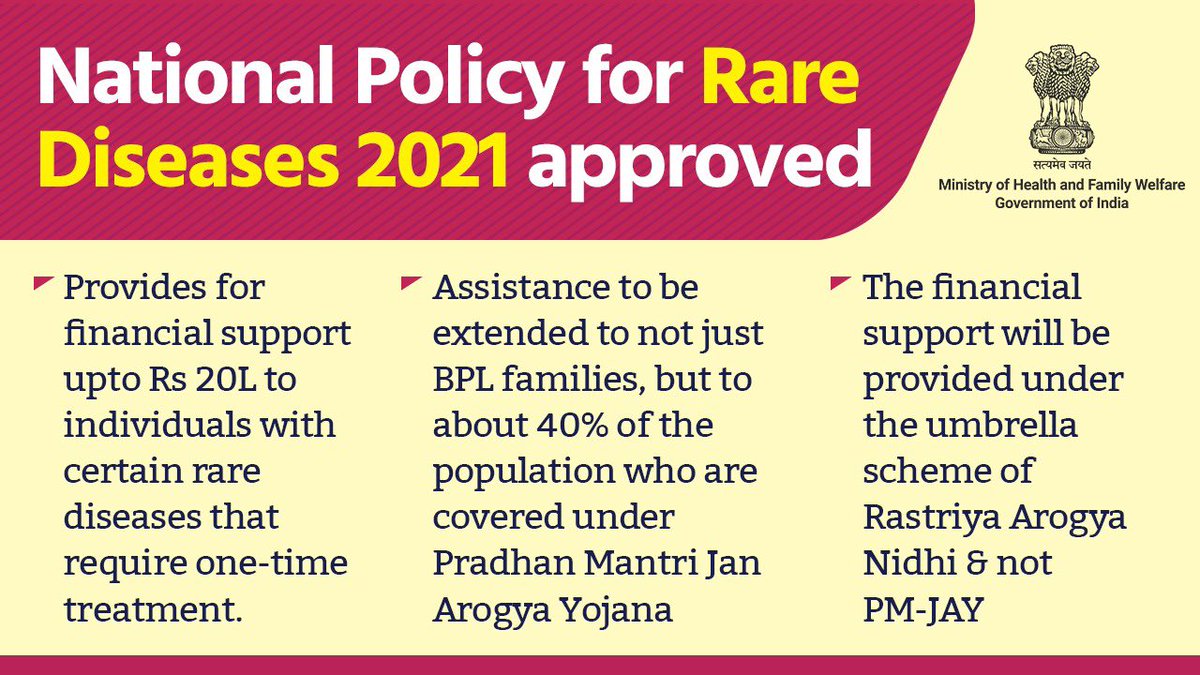
NATIONAL RARE DISEASE POLICY 2021
CONTEXT
Recently, the Ministry of Health and Family Welfare has approved the National Rare Disease Policy 2021.
BASICS
Rare Diseases – A rare disease is a disease that affects a smaller percentage of the population compared to other diseases. Its prevalence is very low.
The definition accepted in the United States is that it is a disease that afflicts fewer than 2,00,000 people.
This definition is also accepted by the National Organisation for Rare Disorders (NORD) in India.
Rare diseases came to be known as orphan diseases because pharmaceutical companies were not ready to adopt them and develop drugs for them because of the low prevalence.
That is why the drugs used to treat or manage rare diseases are known as orphan drugs.
Most rare diseases are genetic and thus are present throughout the person’s entire life, even if symptoms do not immediately appear.
Over 6,000 different rare diseases have been identified to date.
o 72% of rare diseases are genetic whilst others are the result of infections (bacterial or viral), allergies and environmental causes.
o 70% of those genetic rare diseases start in childhood.
MAJOR PROVISIONS OF THE POLICY
Categorization – The policy has categorised rare diseases in three groups
o Group 1- Disorders amenable to one-time curative treatment.
o Group 2 – Those requiring long term or lifelong treatment.
o Group 3 – Diseases for which definitive treatment is available but challenges are to make
optimal patient selection for benefit, very high cost and lifelong therapy.
Financial Support – Those who are suffering from rare diseases listed under Group 1 will have the financial support of up to Rs. 20 lakh under the umbrella scheme of Rashtriya Arogya Nidhi.
Rashtriya Arogya Nidhi – The Scheme provides for financial assistance to patients, living below poverty line (BPL) and who are suffering from major life threatening diseases, to receive medical treatment at any of the super specialty Government hospitals / institutes.
o Beneficiaries for such financial assistance would not be limited to BPL families, but extended to about 40% of the population, who are eligible as per norms of Pradhan Mantri Jan Arogya Yojana, for their treatment in Government tertiary hospitals only.
Alternate Funding – This includes voluntary crowdfunding treatment by setting up a digital platform for voluntary individual contribution and corporate donors to voluntarily contribute to the treatment cost of patients of rare diseases.
Centres of Excellence – The policy aims to strengthen tertiary health care facilities for prevention and treatment of rare diseases through designating eight health facilities as ‘Centres of Excellence’ and these will also be provided one-time financial support of up to Rs. 5 crore for upgradation of diagnostics facilities.
National Registry – A national hospital-based registry of rare diseases will be created to ensure adequate data and comprehensive definitions of such diseases are available for those interested in research and development.
